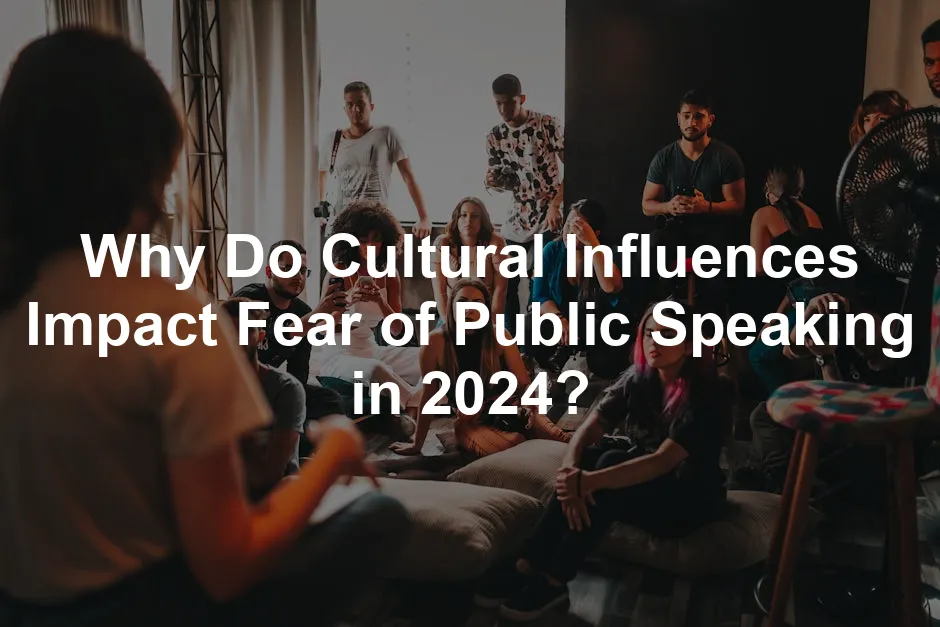
Why Do Cultural Influences Impact Fear of Public Speaking in 2024?
Introduction
In a world where communication connects us all, the fear of public speaking—often called glossophobia—persists as a leading social phobia. It’s ironic, really. Many people would rather swim with sharks than speak in front of a crowd! Interestingly, cultural influences significantly shape this fear. From childhood experiences to societal expectations, our backgrounds play a vital role in how we perceive and react to public speaking situations.
As we step into 2024, understanding these cultural influences becomes crucial. The fear of negative evaluation looms large in many cultures. This fear can stem from the way individuals are raised and the values instilled in them. For instance, in cultures that prioritize collectivism, group harmony is paramount. This can lead to a heightened fear of standing out or being criticized during public speaking. On the other hand, cultures that encourage individuality may foster a different kind of anxiety, one that revolves around the pressure to perform and impress.
Moreover, the impact of technology on global communication is undeniable. In today’s digital age, we’re exposed to diverse cultures and their unique communication styles. This exposure can either alleviate or amplify public speaking anxiety, depending on individual comfort levels. It’s essential to recognize that these cultural influences are not just historical artifacts; they evolve as society does, shaping the way we communicate.
As we embark on this exploration of public speaking anxiety in 2024, we’ll uncover why understanding cultural influences is paramount. For individuals and organizations alike, effective communication hinges on recognizing these influences. So, let’s unravel the intricate tapestry of public speaking anxiety and its cultural threads. With the right insights, we can help transform fear into confidence—one speech at a time.

Summary
This article delves into the complex relationship between cultural influences and the fear of public speaking in 2024. By examining various psychological, physiological, and situational factors, we will reveal how societal norms shape our perceptions of public speaking. Key topics include the prevalence of glossophobia across different cultures, the impact of demographic variables such as gender and age, and the role of environmental expectations. We will also discuss effective coping strategies and interventions, particularly in multicultural settings. By the end of this exploration, readers will gain valuable insights into managing public speaking anxiety while embracing their unique cultural backgrounds.

What is Glossophobia?
Glossophobia is the fear of public speaking, and it’s more common than you might think. Approximately 75% of people experience anxiety when faced with the prospect of speaking in front of an audience. That’s right—three out of four people would rather binge-watch their least favorite reality show than give a speech! If you’re looking for insights on overcoming this fear, check out “Dare to Speak: How to Become a Master Communicator” by Conor Neill. This book offers practical tips to conquer your fears and express yourself with confidence.
This fear can manifest in various ways, ranging from slight nervousness to debilitating panic attacks. Physically, individuals might experience rapid heartbeats, sweaty palms, or even shaking hands. Emotionally, the fear can invoke feelings of dread and embarrassment, leading to avoidance of situations where speaking might be required.
In short, glossophobia is a significant barrier for many, affecting social interactions, academic performance, and professional growth. To tackle these issues, consider exploring “Talk Like TED” by Carmine Gallo, which reveals the secrets of some of the best speakers in the world.

Cultural Perspectives on Fear
How Culture Shapes Communication Styles
Culture plays a pivotal role in shaping how we communicate, influencing our comfort levels when it comes to public speaking. In collectivist cultures, such as Japan and China, the emphasis on group harmony often leads individuals to prioritize collective opinions over personal expression. This can heighten anxiety about speaking out, as standing out may be seen as disruptive. A Japanese student might feel immense pressure to conform, fearing that their unique thoughts could lead to social ostracism.
Conversely, individualistic cultures like the United States encourage self-expression and assertiveness. Public speaking is often celebrated as a key skill, which might reduce anxiety for some. However, the pressure to impress and perform can create a different type of stress, particularly for those who feel they need to meet high expectations. To help ease this transition, consider reading “Confessions of a Public Speaker” by Scott Berkun. It provides insights into the real-life experiences of speakers and how to navigate the pitfalls of public speaking.
For instance, a student in the U.S. might worry about their presentation being judged not just on content but also on delivery and style. This pressure to excel can intensify anxiety, as the audience’s gaze turns into that looming specter of judgment.

Gender Roles and Expectations
Cultural expectations around gender also significantly influence public speaking anxiety. Research suggests that women and non-binary individuals often report higher levels of anxiety compared to men. This disparity can be traced back to cultural norms that dictate how different genders should communicate. In many cultures, women are socialized to be more reserved, while men are encouraged to be assertive.
Statistics reveal that in certain societies, up to 61% of women report feeling anxious about public speaking, compared to 43% of men. This difference is particularly pronounced in cultures that place high value on traditional gender roles. The fear of negative evaluation can loom large, especially for women who may feel their credibility is on the line with every word they utter. To build confidence in public speaking, consider exploring “The Art of Public Speaking” by Dale Carnegie. This classic offers timeless strategies to improve your speaking skills.
In regions where gender equality is still a work in progress, the pressure to conform to societal expectations can heighten anxiety. A woman in a business meeting might feel her contributions are scrutinized more closely than her male counterparts, leading to a cycle of self-doubt and fear.
Understanding these cultural influences not only sheds light on the pervasive nature of glossophobia but also underscores the importance of culturally sensitive approaches to public speaking training. By recognizing these dynamics, we can better support individuals in navigating their unique challenges, ultimately empowering them to find their voice amid the cacophony of societal expectations. If you’re interested in honing your skills further, you might want to check out “Steal the Show” by Michael Port. This book covers the essentials of captivating an audience in any situation.

Psychological and Sociocultural Factors
Fear of Negative Evaluation
Fear of negative evaluation is a significant contributor to public speaking anxiety. This fear revolves around a deep-seated concern about how others perceive us. Imagine standing in front of a crowd, heart racing, palms sweating, and the ever-looming thought: “What if they think I’m terrible?” This anxiety can be especially pronounced in cultures where public opinion holds great weight. In collectivist societies, where group harmony is paramount, the fear of standing out or facing criticism can be paralyzing.
Societal pressure amplifies this fear. Individuals often feel the weight of expectations, not just from peers but from family and community. This pressure can chip away at self-esteem, leaving individuals second-guessing their abilities. For instance, a young professional may worry that a poorly received presentation could lead to career stagnation or social ostracism. The anxiety doesn’t stop at the fear of criticism; it extends to the perception of oneself. The more we fear judgment, the less confident we become in our speaking abilities, creating a vicious cycle. If you’re looking for ways to build that confidence, consider “Presence” by Amy Cuddy. This book dives into the power of body language and how it can affect your confidence and success.
In many cultures, being articulate and confident is highly valued. This creates unrealistic benchmarks, making it easy to feel inadequate. The statistics are telling: around 60% of employees report that their fear of public speaking has hindered their career growth. The fear of negative evaluation intertwines with self-worth, leading individuals to avoid speaking opportunities altogether. It’s a classic case of “you can’t improve what you don’t practice,” and that practice is often stifled by the fear of what others might think.

The Role of Socialization and Early Experiences
Cultural upbringing plays a pivotal role in shaping our views on public speaking. From an early age, children absorb messages about communication through their interactions. Critical parenting, for instance, can sow seeds of doubt. A child who receives harsh feedback for a simple school presentation may develop a lasting fear of public speaking. Negative experiences like being laughed at or criticized can create emotional scars that resurface in adulthood.
Moreover, societal expectations regarding behavior can influence how children express themselves. In many cultures, assertiveness isn’t encouraged for all genders, particularly for girls. This can lead to less practice in speaking up, further embedding public speaking anxiety. Children raised in environments that celebrate expressive communication tend to develop higher confidence levels. Conversely, those from more reserved backgrounds might struggle to find their voice. For those looking for guidance on how to express themselves better, “The Quick and Easy Way to Effective Speaking” by Dale Carnegie is a fantastic resource!
Imagine a classroom where only a few students are praised for sharing their thoughts. The others, even if they have valuable insights, may choose silence over the risk of being wrong. This early socialization shapes their perceptions of public speaking, often leading to a belief that speaking out is fraught with danger.
As these children grow into adults, the patterns established in their formative years can manifest as significant anxiety. This is especially true in professional settings where public speaking is essential. The fear that sprouted from childhood experiences can limit career opportunities and personal growth. Recognizing the impact of these early interactions is crucial in addressing public speaking anxiety in adults. With targeted interventions and support, individuals can learn to reframe these early experiences, transforming fear into confidence and competence. To further explore this journey, consider “How to Win Friends and Influence People” by Dale Carnegie. This classic book can help enhance your interpersonal skills, a crucial aspect of effective public speaking.

By understanding the psychological and sociocultural factors that contribute to public speaking anxiety, we can begin to dismantle the barriers that prevent effective communication. Embracing diverse backgrounds and experiences can lead to a more supportive environment, encouraging individuals to express themselves freely and confidently.

Coping Strategies and Solutions
Cultural Competency in Public Speaking Training
Public speaking training programs must embrace cultural perspectives. After all, one size doesn’t fit all when it comes to communication. Integrating cultural competency can help individuals understand how their backgrounds influence their speaking anxiety. Acknowledging these differences can lead to more effective training.
One shining example is the “Culturally Adapted Public Speaking Program” launched at a university in California. This initiative focuses on the unique needs of international students. By tailoring training to cultural nuances, they’ve seen a remarkable 40% reduction in anxiety levels among participants. Students learn to appreciate their cultural heritage while honing their speaking skills. For those interested in enhancing their presentation skills, consider “The Public Speaking Playbook” by Teri Kwal Gamble. This book provides practical exercises and insights to develop effective speaking strategies.
Another successful program is the “Speak Up! Initiative,” which emphasizes storytelling. Participants from diverse backgrounds share their personal experiences. This approach not only builds confidence but also fosters a supportive community. By creating a platform for sharing, individuals feel valued and understood, easing their public speaking fears.

Training programs that highlight cultural sensitivity empower individuals. They can transform anxiety into confidence. It’s all about understanding the cultural lens through which we communicate. When participants feel seen and heard, they’re more likely to engage and thrive.

Effective Techniques to Manage Anxiety
Managing public speaking anxiety requires a toolkit of effective techniques. Here are some tailored strategies that resonate across various cultural backgrounds.
1. Cognitive Restructuring: This technique challenges negative thoughts. Participants learn to identify their fears and replace them with positive affirmations. For instance, instead of thinking, “I’ll embarrass myself,” one might adopt, “I’m prepared and capable.” This shift in thinking fosters a healthier mindset.
2. Visualization: Imagine standing confidently in front of an audience. Visualizing success helps in reducing anxiety. Participants can mentally rehearse their presentations, focusing on positive outcomes instead of potential disasters. This technique builds familiarity with the speaking environment.
3. Relaxation Methods: Deep breathing exercises can be a game changer. By taking slow, deep breaths, individuals can calm their nerves and reduce physical symptoms of anxiety. Techniques like progressive muscle relaxation also help ease tension before stepping onto the stage. For those who enjoy a creative outlet, consider using a Relaxation and Stress Relief Coloring Book. It can be a fun way to unwind and calm your mind before a presentation.
4. Technology Integration: Virtual reality (VR) training is revolutionizing public speaking practice. Programs like “PresentationPro” offer simulated environments where individuals practice their speeches in front of AI-driven avatars. This immersion helps desensitize participants to the fear of judgment, creating a safe space to refine their skills.
5. Supportive Communities: Group workshops or speaking clubs provide a nurturing environment for practice. By sharing experiences and offering feedback, participants can build confidence together. Programs like Toastmasters foster camaraderie among speakers, making the process less daunting. If you’re looking for a great resource to help you practice, check out “The Confidence Code” by Katty Kay and Claire Shipman. This book delves into the science of confidence and how to cultivate it.
6. Regular Feedback: Constructive feedback can be invaluable. Participants should seek input from trusted peers or mentors. This feedback loop helps to identify strengths and areas for improvement, ultimately building confidence.
These techniques are not just effective; they are adaptable to various cultural contexts. Individuals will find their unique strategies that resonate with their backgrounds. By embracing these methods, overcoming public speaking anxiety becomes a shared journey rather than an isolating experience.

Conclusion
Understanding cultural influences on the fear of public speaking is crucial. It’s not just about the individual; organizations that value effective communication must recognize these influences too. Glossophobia, the fear of public speaking, has deep roots in cultural contexts. By acknowledging its multifaceted nature, we can help individuals confront and mitigate this pervasive fear.
As we venture into 2024, embracing diverse backgrounds can transform public speaking. It’s a chance to connect with others, share stories, and foster growth. Instead of viewing public speaking as a daunting task, let’s see it as an opportunity. An opportunity to express ideas, engage with audiences, and build relationships. To improve your presentation skills, consider reading “Presentation Zen” by Garr Reynolds. It provides practical insights on how to design and deliver effective presentations.
Cultural competency in training is essential. Programs that incorporate diverse communication styles can empower individuals. When training is culturally sensitive, it helps people feel understood and supported. This approach can significantly reduce anxiety associated with public speaking.
Furthermore, organizations can play a pivotal role. Creating supportive environments for practice and feedback encourages individuals to step out of their comfort zones. When people feel safe to express themselves, they are more likely to thrive.
As we move forward, let’s prioritize effective communication. By weaving in cultural understanding, we can help individuals transform their fears into confidence. Public speaking is not solely about delivering a message; it’s about connecting with others. It’s about sharing experiences and fostering mutual understanding. So, let’s embrace our differences and celebrate the diverse voices that make our world richer. Together, we can turn glossophobia into glossophilia—an appreciation for the art of public speaking.

FAQs
What percentage of people fear public speaking?
Approximately 75% of people experience anxiety related to public speaking.
Can cultural background affect public speaking anxiety?
Yes, cultural norms and expectations can significantly shape how individuals perceive and react to public speaking situations.
What are some effective ways to overcome public speaking anxiety?
Techniques include practice, cognitive restructuring, relaxation methods, and utilizing technology for training.
Is public speaking anxiety more common in specific demographics?
Research indicates that women and non-binary individuals often report higher levels of public speaking anxiety.
How can organizations support individuals facing public speaking anxiety?
Organizations can implement culturally sensitive training programs and create supportive environments for practice and feedback.
Please let us know what you think about our content by leaving a comment down below!
Thank you for reading till here 🙂
Understanding the fear of public speaking is crucial for effective communication. Check out this article on why do some people have a fear of public speaking (glossophobia).
Coping strategies are essential in managing anxiety related to public speaking. Learn more about why are coping strategies essential for handling anxiety in daily life.
Effective communication is key in overcoming glossophobia. Discover more about why does effective communication matter in overcoming glossophobia.
All images from Pexels




